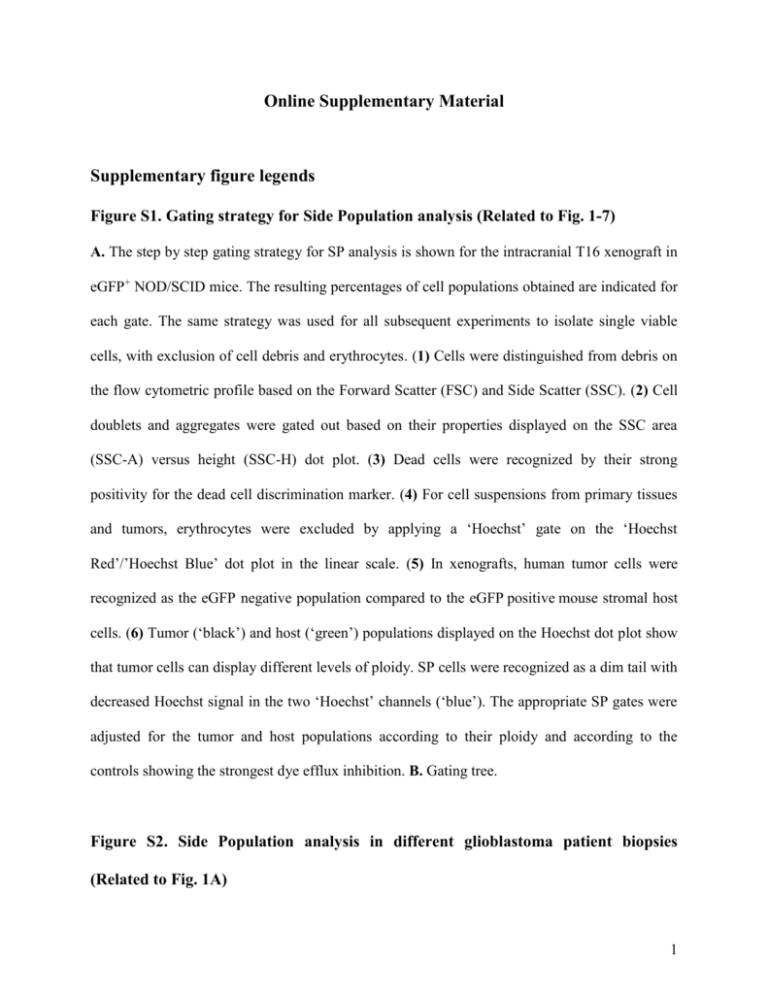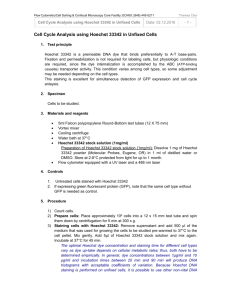Figure S5. Side Population analysis in spheroid and stem
advertisement

Online Supplementary Material Supplementary figure legends Figure S1. Gating strategy for Side Population analysis (Related to Fig. 1-7) A. The step by step gating strategy for SP analysis is shown for the intracranial T16 xenograft in eGFP+ NOD/SCID mice. The resulting percentages of cell populations obtained are indicated for each gate. The same strategy was used for all subsequent experiments to isolate single viable cells, with exclusion of cell debris and erythrocytes. (1) Cells were distinguished from debris on the flow cytometric profile based on the Forward Scatter (FSC) and Side Scatter (SSC). (2) Cell doublets and aggregates were gated out based on their properties displayed on the SSC area (SSC-A) versus height (SSC-H) dot plot. (3) Dead cells were recognized by their strong positivity for the dead cell discrimination marker. (4) For cell suspensions from primary tissues and tumors, erythrocytes were excluded by applying a ‘Hoechst’ gate on the ‘Hoechst Red’/’Hoechst Blue’ dot plot in the linear scale. (5) In xenografts, human tumor cells were recognized as the eGFP negative population compared to the eGFP positive mouse stromal host cells. (6) Tumor (‘black’) and host (‘green’) populations displayed on the Hoechst dot plot show that tumor cells can display different levels of ploidy. SP cells were recognized as a dim tail with decreased Hoechst signal in the two ‘Hoechst’ channels (‘blue’). The appropriate SP gates were adjusted for the tumor and host populations according to their ploidy and according to the controls showing the strongest dye efflux inhibition. B. Gating tree. Figure S2. Side Population analysis in different glioblastoma patient biopsies (Related to Fig. 1A) 1 All Glioblastoma patient biopsies displayed a well-defined SP. Efflux properties were confirmed by inhibition controls (250µM Verapamil + 10µM FTC). Figure S3. Side Population analysis in patient biopsy-derived xenografts (Related to Fig. 1E) All patient derived xenografts in eGFP+ NOD/SCID mice (‘grey’) contained a well-defined SP (n = 3). Discrimination between host stromal (‘green’) and tumor (‘black’) compartment revealed SP uniquely in the stromal compartment of the xenograft (‘blue’), confirmed by inhibition controls. Figure S4. Flow cytometric sorting controls of glioblastoma xenograft and normal brain populations (Related to Fig. 2C-D, Fig. 4C-E and Fig. 5A) A. T16 xenografts (n = 8) were used for the SP assay followed by FACS analysis. Since T16 tumor cells display amplification of the EGFR gene (Table S1), these can be easily recognized by EGFR staining. Human-specific EGFR staining was therefore added to eGFP discrimination to increase the number of events and the purity of the gates used for sorting. Tumor cells were characterized as eGFP-EGFR+ main population (MP) events (‘Tumor MP’), whereas stromal host cells were divided into eGFP+EGFR- SP (‘Stromal SP’) and MP (‘Stromal MP’). B. Sorted populations were reanalyzed directly after each sorting experiment. The purity of populations with regard to EGFR/eGFP expression was > 98%. C. SP analysis after sorting showed that eGFP+EGFR- SP events were >98% pure. eGFP+EGFR- MP events appeared with a slightly decreased ‘Hoechst Red’ signal, due to additional washing and instability of the Hoechst staining in this channel. Nevertheless, 99% of events were outside the SP gate. All eGFP -EGFR+ sorted 2 cells were aneuploid and 93-99% of events were present in the Tumor MP gate. Graphs show representative examples of sorted populations (n = 8). Sorted Stromal SP and MP and Tumor MP were used for functional assays and gene expression analysis. Any events detected in the Tumor SP gate during prolonged experiments were sorted, however the number of events was extremely low (<100 events from 3-5 xenografts) and after reanalysis, the sorted cells were mostly present outside the SP gate, with ‘dead’ cell-like properties (not shown). D. Normal brain sorting. Single cell suspension of normal brain was sorted as SP (‘Brain SP’) and MP (‘Brain MP’) fraction. E. Sorted Brain SP was >94% pure. Similarly to the eGFP+EGFR- Stromal MP, Brain MP appeared with a decreased ‘Hoechst Red’ signal during reanalysis. Sorted cells were used for functional assays and gene expression analysis. Figure S5. Side Population analysis in spheroid and stem-like cell line derived xenografts (Related to Fig. 2) A. Related to Fig. 2A. All respective patient derived xenografts contained SP (‘blue’) exclusively in the stromal compartment (‘green’). Tumor cells (‘black’) were deprived of SP, regardless of tumor cell ploidy (T16 displayed diploid and aneuploid tumor cells, P3 and P8 were purely diploid tumors (n = 3)). B. CD133 and CD15 expression of tumor cells in patient derived xenografts. CD133+ and CD15+ cells are present at varying levels in the tumor population of respective xenografts (‘black’) and the expression level strongly varies between tumors. Expression levels are displayed compared to negative controls (‘grey dotted’). C. SP profiles of tumor and stromal cells in T16 xenografts were unchanged upon TMZ treatment of the mice. D. Related to Fig. 2B. CD133 and CD15 expression in NCH glioblastoma stem-like cell lines. Expression levels (‘grey’) are displayed compared to negative controls (‘grey dotted’). E. 3 NCH421k cell line did not possess efflux properties in vitro (n = 5). Tumor/host discrimination in the NCH421k xenograft in eGFP+ NOD/SCID mice revealed that the SP (‘blue’) is exclusively present in the stromal compartment (‘green’). NCH421k cells (‘black’) were aneuploid and the SP tumor gate was adjusted accordingly (n = 3). Figure S6. Side Population phenotyping in glioblastoma patient biopsies (Related to Fig. 3) A. CD31/CD105 phenotyping. CD31+ SP cells co-expressed CD105 in patient biopsies, indicating their endothelial nature. A low number of tumor cells that were either CD31+ or CD105+ were detected in the respective xenograft. However the level of expression of CD31 was 10-100 times lower compared to endothelial cells in patient biopsies and these cells were never CD31/CD105 double positive. B. EGFR/A2B5 phenotyping. All SP events, including A2B5+SP were EGFR-. C. CD45/CD31 phenotyping. SP events were enriched in CD31+ cells, no CD45+ hematopoietic SP events were observed. The respective xenografts contained <0.1% of CD31+ and CD45+ tumor cells, at a background detection level. Figure S7. Multicolor Side Population phenotyping in stromal compartment of the xenograft (Related to Fig. 4 and Fig. 5A) A. Related to Fig 4. CD105/CD44 phenotyping. SP was enriched in CD105+CD44- cells, whereas CD105+CD44+ cells were only in MP. Less than 0.3% SP was CD105-CD44+. B. CD90/CD44 phenotyping. SP was enriched in CD90+CD44- cells, whereas CD90+CD44+ cells were only in MP. Less than 0.1% SP was CD90-CD44+. The CD90 expression level detected by flow cytometry was not strong enough for accurate discrimination and was therefore not 4 included in our calculations C. CD15/CD133 phenotyping. CD15+CD133+ and CD15+CD133NSC/NPC-like cells were only in MP, whereas SP was enriched in CD15-CD133+ cells, confirming their EC origin. D. A2B5+ cells in the mouse brain can be detected in close proximity to CD31+ endothelial cells reminiscent of perivascular astrocytes. The arrow points at a putative ‘end-feet’-like structure. E. Gene expression profile of Nestin and Vimentin in sorted SP and MP populations of stromal compartment of the xenograft and in normal brain further confirmed the endothelial nature of the SP. Both Nestin and Vimentin could not be used as unique NSC/NPC markers as they are expressed by a number of other cell types in the brain, including endothelial cells (see Table S2). F. Related to Fig. 5A. Gene expression analysis of the ABC transporter family members. ABCBC1, ABCC2, ABCC3 and ABCC5 transporters were not enriched in the SP, indicating a lack of direct involvement of these transporters in the dye efflux properties in the brain and gliomas. 5 Supplementary tables Table S1. Clinical patient data and chromosomal aberrations of corresponding human glioblastoma biopsies Modifications in genome structure as identified by aCGH are shown for each patient tumor and glioblastoma stem-like cell line. [++ = amplification (Log2 Ratio>2), + = gain (Log2 Ratio >0.35), - = loss (Log2 Ratio < -0.35), -- = deletion (Log2 Ratio < -1)]. The last column indicates the experiment for which the patient biopsies were used. For xenografts the mean time to sacrifice (days +/- SEM) and the number of mice (n) are indicated. Patient Chromosomal aberrations Patient Patient age sex biopsy T16 ++[EGFR , MDM2], +7q, - [Chr6q, Chr10, Chr11, 13q12- 52 F q32.2], --CDKN2A/B T101 ++[EGFR, MDM2] +Chr7, -[3q, Chr4, Chr10, Chr11, ++EGFR, +Chr7, -10q, --CDKN2A/B Xenograft (74 +/- 2 ; n = 16) 60 M Chr15], --CDKN2A/B T185 Experiment Xenograft (91 +/ 0.4 ; n = 10) 76 F Xenograft (142 +/0.5; n = 6) T233 ++EGFR, 2q34 +1q21.2-24.2, Chr7, Chr19, Chr20, 43 F -9p21.3 -21.1, Chr10, --CDKN2A/B T238 +Chr7, -[6q, 9p-p21.1,Chr10, Chr13] Xenograft (129 +/10; n = 6) 41 M Xenograft (139 +/- 1; n = 3) T239 +[Chr7, Chr19], -[1p-p35.3, 9p24.2-p23, 9p21.3-p21.1], -- 79 M CDKN2A/B T251 ++EGFR, 2q34, +1q21.2-24.2, Chr7, Chr19, Chr20, n = 6) 43 F -9p21.3 -21.1, Chr10, --CDKN2A/B T316 -[Chr6, 9p, Chr10, 11p, Chr13, Chr14, Chr18, 22q12.3- Xenograft (140 +/- 6; Xenograft (103 +/7.5; n = 7) 51 M FISH analysis 70 M FISH analysis 84 M FISH analysis qter] T330 ++EGFR, +Chr7, -[Chr6, 9p, Chr10, Chr14, 16q, 18p], -CDKN2AB T331 ++EGFR, +[Chr1, Chr7, Chr20], -[9p, Chr10, Chr22], --PTEN 6 T341 ++PDGFRA, 7p21.1, EGFR, 7q21.1-22.2, 17p12, 1Chr7, 75 F FISH analysis 64 M Xenograft (37 +/- 4; Chr16, Chr19, -Chr10, --CDKN2A/B P3 + [Chr 7, Chr19, 20q], -[1q42-q43, Chr9, Chr10, 20p] --[PIK3R , CDKN2A/B] P8 ++EGFR, +[5q31-q35, Chr7, 8q24], -[6q22-q24, Chr10, n = 8) 64 F 13q13.3-q33.3, 18q21.2-q22.4], --CDKN2A/B Xenograft (64.5 +/0.5; n = 8) Cell Line NCH421k ++[PDGFRA, MYC, CDK4], +[1p31.1-q43, 5q1-q22.2, N/A M 16p], -[2q, 3p-q13.31, 8p, 9p, Chr10, 13q] NCH644 ++MYC, +[5q34-qter, EGFR, 8p, 8q-8q22.3, 20q11.23-qter, Chr21, Chr22], -[5q32.2-q34, 12q24.12-q24.32, 13q-q31.1, Xenograft (71 +/0.8; n = 21) N/A F Xenograft (31.5 +/1; n = 14) 18q, Chr19] 7 Table S2. List of lineage-specific markers used in the study NSC: neural stem cells, NPC: neural progenitor cells, EC: endothelial cells, EPC: endothelial progenitor cells, HSC: hematopoietic stem cells; MSC: mesenchymal stem cell Protein A2B5 Full/alternative name Lineage specificity in normal brain c-series gangliosides, Neural and glial precursors, late oligodendrocyte precursors, immature astrocytes, Aif1 Allograft inflammatory factor 1, IBA1, Ionized calcium binding microglia, macrophages adaptor molecule 1 CD11c Integrin alfa X, p150/90 microglia, macrophages/monocytes, myeloid cells, granulocytes CD15 sialyl Lewis X, (LeX ), Stage-Specific NSCs, NPCs, neurons Embryonic Antigen-1 (SSEA-1) CD31 CD44 CD45 Platelet endothelial cell adhesion ECs, lymphocytes, platelets, macrophages, T/NK cells, molecule-1 (PECAM1) granulocytes, neutrophils Heparan sulfate proteoglycan receptor, glial precursors and glial cells, microglia/macrophages, MSCs, Pgp-1 hematopoietic cells Protein tyrosine phosphatase, receptor macrophages, hematopoietic cells type, C (PTPRC) CD90 Thy-1 cell surface antigen ECs, neurons, MSCs, fibroblasts CD133 Prominin-1 (PROM1) NSCs, NPCs, ECs, EPCs, HSCs CD105 Endoglin ECs, mesenchymal cells, MSCs, fibroblasts Desmin GFAP pericytes, MSC, fibroblasts, smooth muscle cells Glial fibrillary acidic protein NSCs, NPCs, astrocytes Nestin NG2 Olig2 NSCs, NPCs , pericytes, ECs Neuron-Glial 2 chondroitin sulfate pericytes, macrophages , glial progenitor cells, oligodendrocyte proteoglycan precursors, Oligodendrocyte transcription factor 2 motor neurons, oligodendrocyte progenitors Vimentin NSCs, NPCs, ECs, pericytes, microglia, fibroblasts, smooth muscle cells vWF von Willebrand factor, VWF ECs 8 Table S3. List of antibodies used in the study Epitope Conjugate Species reactivity Clone Supplier Concentration used/test* A2B5 APC/PE human, mouse 105-HB29 Miltenyi 10µl/test ABCB1 PE human CD243 UIC-2 Chemicon 1µl/test ABCG2 APC human CD338 5D3 Biolegend 20 µl/test CD11c APC mouse N418 eBioscience 1.2µl/test CD11c PerCP mouse N418 Biolegend 2.5µl/test CD15/SSEA-1 Alexa Fluor 647 human, mouse MC-480 Biolegend 5µl/test CD15/SSEA-1 PE human MEM-158 Immunotools 10µl/test CD31 Dy590 (PE-TR) human MEM-05 Immunotools 10µl/test CD31 APC mouse MEC 13.3 BD Bioscience 5µl/test CD31 APC/PE-Cy7 mouse 390 eBioscience 2.5µl/test CD44 PE-Cy7 human, mouse IM7 eBioscience 1.2µl/test CD45 PE human MEM-28 Immunotools 10µl/test CD90 APC human 5E 10 BD Bioscience 5µl/test CD90 PE/APC mouse G7 Beckman Coulter 2µl/test CD133 PE /APC human 293C3/AC133 Miltenyi 10µl/test CD133 PE/APC mouse 13A4 eBioscience 5µl/test CD105 PE mouse MJ7/18 eBioscience 2.5µl/test CD105 APC human MEM-226 Immunotools 10µl/test EGFR PE human EGFR.1 BD Bioscience 20µl/test NG2 PE human, mouse LHM-2 R&D 10µl/test *Flow cytometry test: 106 cells/100µl 9 Table S4. List of mouse-specific primer sequences used in the study To avoid false positive signals originating from DNA contamination all PCR primers were mouse-specific and designed with known amplicon size, and where possible flanking a region that contains at least one intron. Target Primer F Primer R ABCB1A CAAAAGGAAGCTGGAGGTACA CCACATGACCAAGACAGGAA ABCB1B CTGAGGCCGCTGCTTCCATCTT CGTGCCACCTCCGGGTTTCCTT ABCC1 CAAAAAGGTGGCGAGCAG GCCCCAGTGTTACTGGTCA ABCC2 GATGGCCAAGGAAGCCGGCATT GCCAACCTGAGCAACAGCAACAAAC ABCC3 GGAGGCCGCAGAGGGTGAGA TGGCTGGCTGCTCACGAACG ABCC4 CGGTGCACACCGAGGTGAAACC CACCAGAAGAACACGCGCGAG ABCC5 GCAAGAGCCCTGCTGCGTCA CTGTGTGCAGGCGATGGGCA ABCG2 AAATCCGCAGGGTTGTTGTA GCCTTGGAGTACTTTGCATCA ACTIN TCTTGGGTATGGAATCCTGTG CGGATGTCAACGTCACACTT AIF1 GGACTGCTGAAGGCCCAGCA TCCTCGGAGCCACTGGACACC DESMIN CAGCCCCGAGCAAAGGGGTTC TGACAACCTCTCCATCCCGGGT GAPDH GAAGACACCAGTAGACTCCACGACA ATGTTCCAGTATGACTCCACTCAC GFAP TGGAGGGCGAAGAAAACCGCATCAC TTGGCCTTCCCCTTCTTTGGTGC NESTIN GCCAGAACCCCCACCTTGGC AGGGAAGTGGTCCGGCTGCT OLIG2 AGGTTCTCCTCCGCAGCGAGC GTTCTGGGGACGATGGGCGAC VIMENTIN AACAACGATGCCCTGCGCCA GCTCCAGGGACTCGTTAGTGCCT VWF CACTCCAGGCGCGATGCTGT TGATGCTGTGGAACCGCGCT 10 Supplementary material and methods Flow Cytometer settings for SP analysis The FACS AriaTM SORP cytometer (BD Biosciences), fitted with a 632nm (30mW) red laser, a 355 (60mW) UV laser, a 405nm (50mW) violet laser and a 488nm (100mW) blue laser was used. The Hoechst dye was excited by the UV laser and fluorescence was collected in two channels: ‘Hoechst Blue’ 450/50 band-pass (BP) filter and ‘Hoechst Red’ 660/40 long-pass (LP) filter. A LP635nm dichroic mirror was used to split the emission wavelengths. The flow cytometer was stabilised for at least 1h before laser alignment and data acquisition. The Coefficient of Variation of the instrument (%CV) was routinely examined before each experiment. Routinely a 100µm nozzle and window extension (WE) 5 were used for data acquisition and sorting. Cell acquisition and sorting were performed at 4°C at a low fluidic sample speed. Data acquisition and analysis were done with DIVA software (BD Bioscience). To preserve the Hoechst profile and cell viability, all sorting experiments were performed directly after staining and under cold conditions. Although an influence of Hoechst toxicity on cell survival was observed compared to control sorting using only phenotyping markers, there was no difference in viability within Hoechst stained populations (not shown). Hoechst concentration curves with efflux inhibitors were performed in normal brain and xenograft host (not shown). The inhibition was strongest by simultaneously applying Verapamil and FTC at a concentration of 10µM and 250µM respectively. Importantly, as the tumor tissue contains both human and mouse cells, dye efflux behavior was tested after different Hoechst incubation times, as suggested for different species (Petriz, 2007). Nevertheless, no difference in the Hoechst staining pattern was detected between 90 and 120min of Hoechst incubation. 11 Immunohistochemistry Hematoxylin and eosin (H&E) staining and EGFR immunohistochemistry (human-specific antiEGFR antibody; clone E30; DAKO) were performed on formalin-fixed paraffin-embedded sections (7-10 µm) with standard procedures (Envision kit K4011/K4007, Dako). Direct eGFP fluorescence was observed on paraformaldehyde-fixed cryostat sections. Immunostaining for mouse endothelial cells was carried out on fresh-frozen acetone/chloroform-fixed sections with a rat anti-mouse CD31 antibody (CBL1337, Chemicon), visualized with an anti-rat Alexa Fluor 555 secondary antibody (Invitrogen). A2B5+ astrocytes were detected with a preconjugated anti human/mouse A2B5-Alexa Fluor 488 antibody (MAB312RX, Chemicon). Sections were counterstained with 4’,6’-diamidino-2-phenylindole (DAPI). Fluorescent and brightfield images were obtained using a Leica DMI 6000B microscope and the LAS software (Leica Microsystems). Vessel number was calculated based on the mouse CD31 staining using ImageJ software. Vessel counts were computed as a percentage of vessels in treated animals versus controls. Array comparative genomic hybridization (aCGH) Each tumor biopsy was analyzed for chromosomal aberrations using a human-specific aCGH. Genomic DNA was extracted using the DNAeasy Blood and Tissue Kit (Qiagen). DNA was fragmented (200-500bp) by DNAse1 (rDNAse1, Ambion) and labelled with the BioPrime aCGH Genomic labeling Kit (Invitrogen) and Cy3 and Cy5 dyes (GE Healthcare) following standard protocols for Agilent aCGH. Female DNA pool (Promega) was used as a reference. Labelled DNA was hybridized to SurePrint G3 Human 2x400k CGH microarrays (Agilent Technologies). The slides were scanned at 3μm resolution (Agilent High-Resolution Microarray scanner), the 12 image data was extracted using Feature Extraction (Agilent Technologies) and analysed with the Genomic Workbench software (Agilent Technologies). Aberrations were called using the ADM2 algorithm with a threshold setting of 25, centralization ‘on’ with threshold of 25 and an aberration filter with a minimal number of probes=5 and a minimal AvgAbsLogRatio=0.45. Supplementary references Petriz, J. (2007). Flow cytometry of the side population (SP). Curr Protoc Cytom Chapter 9, Unit9 23. 13










